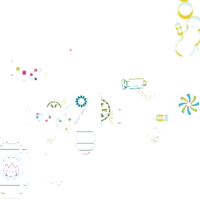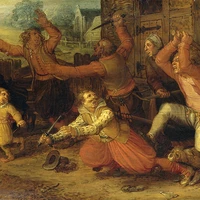Interdependence and autonomy in organizational relations
In part 1 ‘New types of organizations are not new’, organizations are seen as changing networks of relations between units. These relations are best characterized in terms of balances between interdependence and autonomy and, on a less abstract level, between steering and self-organization. Over the centuries we witness an increase in interdependence as well as autonomy. External controls become internalized as self-discipline. This higher level of self-organization and autonomy enables more adequate steering. Gradually, the ability of organizations to deal with complexity improves. This often provides a competitive edge.
This articulation of steering and self-organization is a process which shows a remarkable continuity. So-called new types of organizations are recent expressions of this same process. The concept of better steering and more self-organization applies not only to organizational innovation but also to change management. It provides some important clues which will be described in the next sections.
Change management
Often change efforts are programmed in ways that are difficult to link with steering and self-organization. Change management always involves steering and directing. But are we steering in such a way that the power and the responsibility of the line organization is strengthened? Or does the change effort promote disempowerment and irresponsibility. The next two examples show how good intentions have dubious effects.
| A few years ago a commercial bank set out on a large-scale project of quality improvement. The campaign was launched by a few top managers with much fanfare; spectacular events, special start-up days, posters and special quality symbols typified the first phase. Task forces and project groups set to work throughout the company and an extensive training program was implemented. The central project organization, which coordinated all the efforts, has worked out a well-constructed 10-step plan that was to be used as a scenario.
Today the project is stagnating. Employees are disappointed. For the most part, the measurement and analysis techniques to which the expensive training program devoted so much attention are not being applied. The top managers who launched the project now give the impression that they have lost both their interest and their enthusiasm. A few of them are even suggesting that things are “back to normal". Many of the middle managers are acting downright obstreperous. They feel that the blame is being thrust upon their shoulders, even though they never had any influence on the project. They were the ones who had to keep things moving despite the loss of their personnel to training and project group activities. It is becoming increasingly apparent that, although there are plenty of ideas for improving quality, the old points of contention such as struggles for competencies, centralization versus decentralization and faulty communication and inflexible relations are making progress difficult. In a recent evaluation, the central project group revealed that the project, with its carefully worked-out 10-step plan and exemplary organization, had in fact stimulated bureaucratic tendencies, whereas the objective had been to convert rigidity and bureaucratization into motivation and entrepreneurial action. The bank is now looking for a way of breaking through the impasse. |
Thus, change came to a halt. Steering and self-organization were not developed; even worse, they were hampered. Line management was lead to irresponsible behaviour. The next example explains this in greater detail.
A visibly pleased manager of a large production department remarked that the company’s quality project was as good as dead. At last work could get back to normal. He felt that for years he had been pressured by all kinds of requests (i.e. orders) to have employees participate in project groups. A merry-go-round of training and education had put impossible pressure on the planning. Everybody had been forced to improvise and work overtime to keep things going. In addition there were countless activities by external consultants who kept getting in the way. Their report on avoidable quality costs in particular had gone down very badly with him and his people. "As if we don't work like crazy here!!" he explained. Anyway, the training courses were over, the project groups had done their jobs. There were just going to be some meetings to pass on the recommendations. "Well, let them figure it out". "I guess the coordinators will know what to do with it." By then most of the Q-coordinators had chucked it in. The man presently in charge did not have to be taken seriously, and his assistant was still a rookie!
The medium is the message
People always agree that the responsibility for change belongs to the line organization. But then every effort is made to undermine this responsibility through the ample use of project groups, steering committees, training programs and impressive 10-step change packages.
I would suggest: Forget the 10-step fix-it programs! Do relate change efforts to the steering and self organization of the line organization. Policy down, actions up! Maurice, Wedgwood and Von Moltke were doing this in their own way (as described in part 1). The next two cases provide examples of the possibilities in modern times. Each situation begs an approach of its own, guided by the same concept.
| Case Customer orientation
The management of DECS (approx. 750 employees) that installs and supplies food-dispensing machines concludes that increasing competition demands improved customer orientation. It concerns Douwe Egberts Coffee Systems in the Netherlands, a subsidiary of Sara Lee/DE. In the Netherlands they run 55.000 machines with 33.000 clients. Among others these machines produce yearly 2,5 billion cups of coffee. The management team of DECS develops an approach to improve the customer orientation. All the units in the organization will work systematically on four questions. These questions are:
All units start off with a brief work conference lasting half a day/one day. The progress of the customer orientation process becomes a fixed item on the agenda for the team meetings of all units. Every three months all managers meet to exchange up-to-date information on the state of affairs. Progress is reported in an internal periodical. Every unit makes its progress visible through a simple reporting system. Departments with outstanding performance records are publicly acknowledged. After one year 150 improvement projects have been started. Countless tangible results have already been achieved: reduced lead times on orders, a reduction of the number of complaints, improved financial results, improved control of the work flow, reduction of temporary labor. |
Output steering & Process dialogue
This change effort was not organized in the common way. There were no project groups. The steering group was the top team, and that was it. No studies were conducted, except by departments and teams themselves. The line organization was included every step of the way. Each manager was challenged to show more responsibility for the (internal) customers of his unit. Issues on the inter-unit level were the responsibility of the higher manager in question. Every unit in the company was expected to show results. In this way change management is more in line with developing the capacities of steering and self organization in the line.
Does the success of this approach at DECS means that change always goes smoothly and without any problems? Not at all, there is no easy way! A case in which the process went much less smoothly is illustrative of this.
| Case ‘Cost reduction’ A chemical corporation set out to achieve 'quality improvement' and 'cost leadership'. As in the first case, units have to come with improvement plans of their own. The start seems promising. Some examples of improvements are:
However, no momentum developed; improvements remain isolated. Supportive work conferences for the regular work teams about action planning and working with indicators keep things rolling, but only on a superficial level. It takes two years to get to the point at which improvement is discussed on a regular basis. Even then, results remain few. Apart from occasional actions there is still no momentum. Mentality and company culture have an obstructing effect. Doubts remain about management's motivation. Managers declare their maximum commitment over and over, but they are unable to translate it into action. Other issues, including many operational problems, distract attention. Two interventions eventually put the project back on track. (1) All managers are obliged to put the improvement project on the agenda of every meeting they have with their people. (2) Each unit has to report on the results using performance indicators that are kept up to date by the people involved and are displayed in such a way that all can see and examine them. These two stimuli are consistently maintained - even enforced at times - by management. This deliberate steering finally proves to work. |
What causes the different pace in these two examples? In both cases the essence of the approach is that units should come up with improvement actions and that the regular line organization remains responsible. In the first case management guidance was more focused and determined because the top managers were more of a team. In addition, the organizational units responded better because they had the ability to extract the message and go to work. In the second example, managers were enticed into getting involved with operational details time and again. One might say that the managers in the first case were better able to delegate and coach. But their job was also much easier, because the lower echelons were quicker on the uptake and better able to develop action for their own unit. The next figure summarizes this approach of 'policy down, improvement actions up'.
Change management as developing steering and self-organization
Policy down, actions up!

|
• Top develops a focus for the organization |
• Each unit develops own improvement actions |
|
• The line organization directs and monitors |
• Each unit shows visible results |
Raising levels of commitment and responsibilty
Organizations are seen in a historical perspective as changing networks of relations between units. These relations are characterized as balances between interdependence and autonomy and between steering and self-organization. A higher level of self-organization and autonomy enables more adequate steering. This contributes to competitive advantage.
It is a most interesting conclusion that change efforts often does not live up to their promises because the line-organization is involved in rather awkward ways. The ample use of project groups, task-forces, steering committees, special coordinators, elaborate training programs and all kinds of analysis and research by internal or external agents and consultants obstruct the development of steering and self-organization in the line-organization. An approach more in line with the development of these capacities is briefly described and clarified with several examples.
Request
Are there elements in this contribution you recognize? You are invited to share your experiences, ideas, comments or questions in the interactive space with this article.
The author
Willem Mastenbroek, professor at the Faculty of Economics, Vrije Universiteit, Amsterdam.
Notes
Beer, M., Nohria, N. Eds. (2000) Breaking the Code of Change. Boston, Mass.: Harvard Business School Press.
Mastenbroek, W.F.G. (1996) Organizational Innovation In Historical Perspective: Change As Duality Management. Business Horizons. Volume 39, number 4.
Gerelateerde artikelen

Besturing als Evolutie
Willem Mastenbroek

Organizational Innovation in Historical Perspective, part 1
Willem Mastenbroek

Organizational behavior in historical perspective 2
Willem Mastenbroek



Deel uw ervaringen op ManagementSite
Wij zijn altijd op zoek naar ervaringen uit de praktijk, wat werkt wel, wat niet.
SCHRIJF MEE >>
Als u 3 of meer artikelen per jaar schrijft, ontvangt u een gratis pro-abonnement twv €200,--